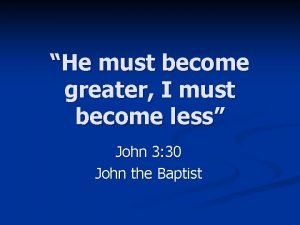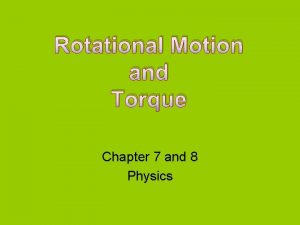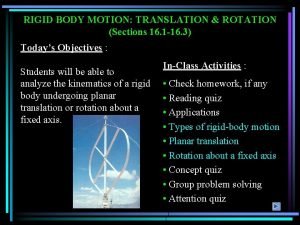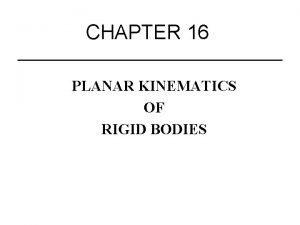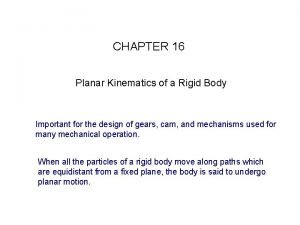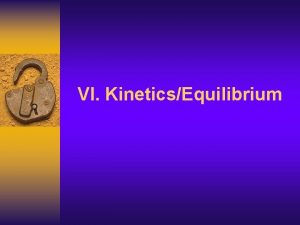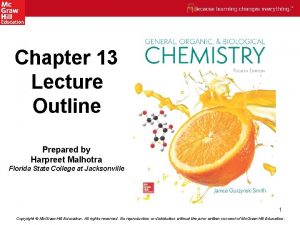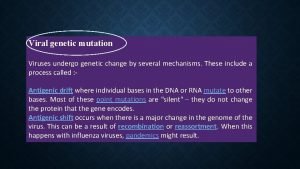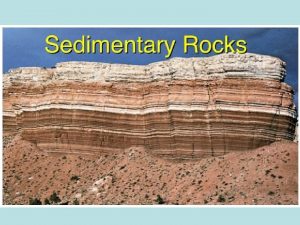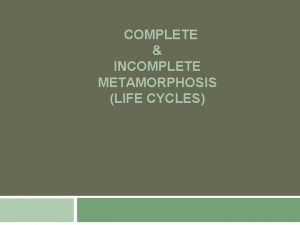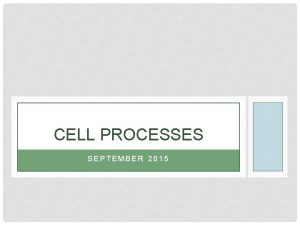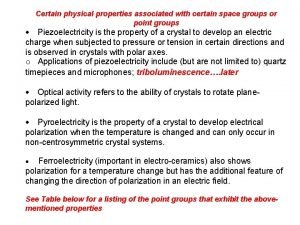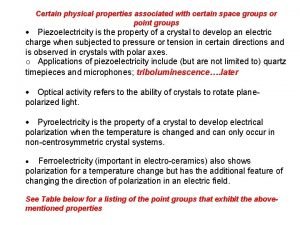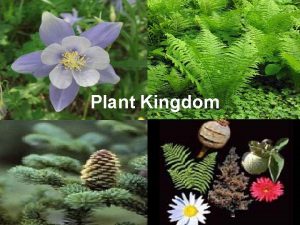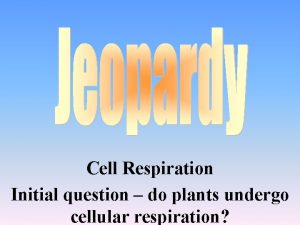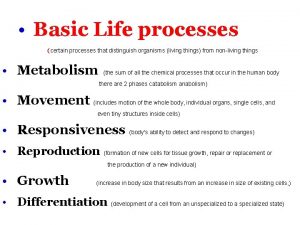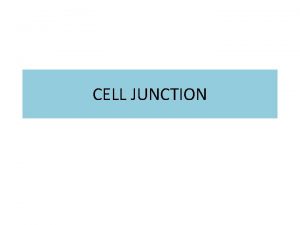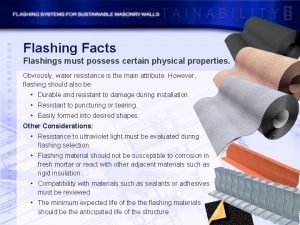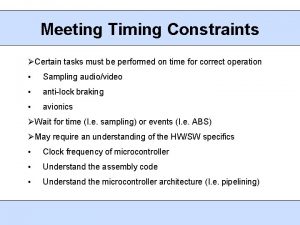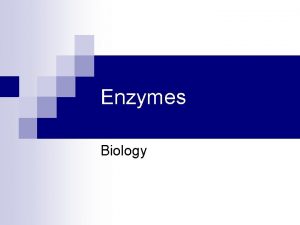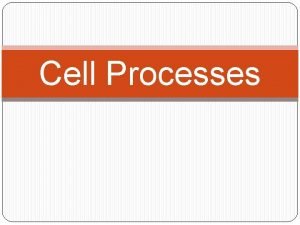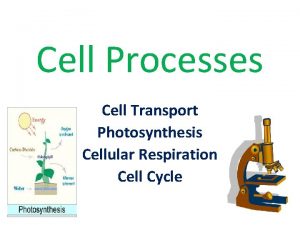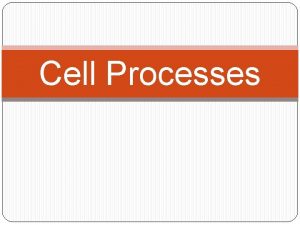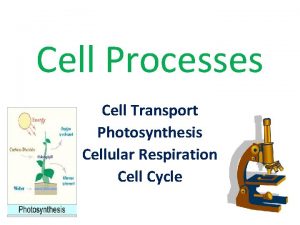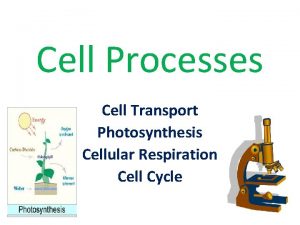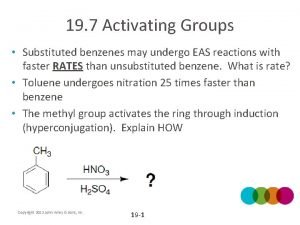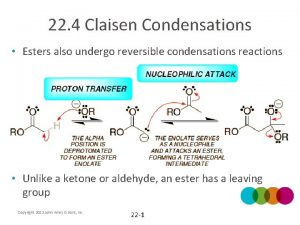Cell Processes The CELL must undergo certain processes
































- Slides: 32

Cell Processes The CELL must undergo certain processes in order to ensure the survival of the organism as a whole.

PHOTOSYNTHESIS • Autotrophic Process: Plants and plant-like organisms make their energy (glucose) from sunlight. • Stored as carbohydrate in their bodies. • 6 CO 2 + 6 H 2 O + sunlight C 6 H 12 O 6 + 6 O 2

Photosynthesis • Plants use light energy (sunlight) to combine carbon dioxide (CO 2) and water (H 2 O) to make simple sugars (C 6 H 12 O 6)

Why is Photosynthesis important? Animals cannot make their own food so they have to rely on other organisms for nutrition. Makes organic molecules (glucose) out of inorganic materials (carbon dioxide and water). It begins all food chains/webs. Thus all life is supported by this process. It also makes oxygen gas!!


What is all this “food” (better known as glucose) used for? • It can be used by the plant to make energy in the mitochondria • It can be stored by the plants in vacuoles • It can be eaten by a consumer

Photo-synthesis means "putting together with light. " Plants use sunlight to turn water and carbon dioxide into glucose. Glucose is a kind of sugar. Plants use glucose as food for energy and as a building block for growing. Autotrophs make glucose and heterotrophs are consumers of it.

What happens during photosynthesis? • Chloroplasts in plant cells capture light energy and use that energy to make glucose or “food” • Oxygen gas is also released as a byproduct in this reaction

Chloroplasts make the sugars!

Stoma This opening how plants exchange gases! Check it! Can you name the two important gases that go in and out of the leaves? Why are the stomata located on the underside of leaves?

PHOTOSYNTHESIS • Absorbing Light Energy to make chemical energy: glucose! – Pigments: Absorb different colors of white light (ROY G BIV) • Main pigment: Chlorophyll a • Accessory pigments: Chlorophyll b and Carotenoids • These pigments absorb all wavelengths (light) BUT green! – It is these specific wavelengths that are provide the energy needed to complete photosynthesis

Visible light is only a small part of the electromagnetic spectrum (all forms of light).


Photosynthesis Glucose provides the energy and carbon needed to make other plant materials like wax and proteins.

Photosynthesis Glucose provides the energy and carbon needed to make other plant materials like wax and proteins.

Photosynthesis Glucose provides the energy and carbon needed to make other plant materials like wax and proteins.

Photosynthesis Glucose provides the energy and carbon needed to make other plant materials like wax and proteins.

Oxygen and Sugar!

PHOTOSYNTHESIS • 2 Phases – Light-dependent reaction – Light-independent reaction • Light-dependent: converts light energy into chemical energy; produces ATP molecules to be used to fuel light-independent reaction • Light-independent: uses ATP produced to make simple sugars.

PHOTOSYNTHESIS • Light-dependent reaction (LIGHT Reaction) – Requires light – Occurs in chloroplast (in thylakoids) – Chlorophyll (thylakoid) traps energy from light – Light excites electron (e-) • Kicks e- out of chlorophyll to an electron transport chain • Electron transport chain: series of proteins in thylakoid membrane – Bucket brigade

PHOTOSYNTHESIS • Light-dependent reaction (LIGHT Reaction) – Energy lost along electron transport chain – Lost energy used to recharge ATP from ADP – NADPH produced from e- transport chain • Stores energy until transfer to stroma • Plays important role in light-independent reaction – Total byproducts: ATP, NADP, O 2

PHOTOSYNTHESIS • Light-independent reaction (Dark Reaction) – Does not require light – Calvin Cycle • • Occurs in stroma of chloroplast Requires CO 2 Uses ATP and NADPH as fuel to run Makes glucose sugar from CO 2 and Hydrogen


PHOTOSYNTHESIS • What affects photosynthesis? – Light intensity: as light increases, rate of photosynthesis increases

PHOTOSYNTHESIS • What affects photosynthesis? – Carbon Dioxide: As CO 2 increases, rate of photosynthesis increases

PHOTOSYNTHESIS • What affects photosynthesis? – Temperature: • Temperature Low = Rate of photosynthesis low • Temperature Increases = Rate of photosynthesis increases • If temperature too hot, rate drops

Oxygen and Sugar!


Cellular Respiration • ALL organisms break down simple sugars (C 6 H 12 O 6) for the energy they contain

Cellular Respiration • Sugar is broken down into Carbon Dioxide (CO 2) and Water (H 2 O) • The Chemical Formula looks like this: C 6 H 12 O 6 + O 2 CO 2 + H 2 O + ENERGY Sugar + Oxygen Carbon Dioxide + water + ENERGY Or in English…….

What’s this energy for? • To build new cell parts • To repair cell parts • To reproduce cells

Where does it happen? • Cellular Respiration occurs in the mitochondria!!!
 Concurrent in os
Concurrent in os He must become greater; i must become less
He must become greater; i must become less Waves can undergo
Waves can undergo When an object spins it is said to undergo
When an object spins it is said to undergo Curvilinear translation
Curvilinear translation Methods of processing meat and poultry
Methods of processing meat and poultry All cultures undergo
All cultures undergo General plane motion
General plane motion Only lines or bodies undergo angular motion
Only lines or bodies undergo angular motion Collision theory states that
Collision theory states that Aromatic compounds undergo
Aromatic compounds undergo Undergo genetic change
Undergo genetic change How do the rocks stick together to undergo lithification?
How do the rocks stick together to undergo lithification? Frog undergoes incomplete metamorphosis
Frog undergoes incomplete metamorphosis Hình ảnh bộ gõ cơ thể búng tay
Hình ảnh bộ gõ cơ thể búng tay Frameset trong html5
Frameset trong html5 Bổ thể
Bổ thể Tỉ lệ cơ thể trẻ em
Tỉ lệ cơ thể trẻ em Gấu đi như thế nào
Gấu đi như thế nào Tư thế worms-breton
Tư thế worms-breton Chúa yêu trần thế alleluia
Chúa yêu trần thế alleluia Các môn thể thao bắt đầu bằng từ đua
Các môn thể thao bắt đầu bằng từ đua Thế nào là hệ số cao nhất
Thế nào là hệ số cao nhất Các châu lục và đại dương trên thế giới
Các châu lục và đại dương trên thế giới Công thức tính độ biến thiên đông lượng
Công thức tính độ biến thiên đông lượng Trời xanh đây là của chúng ta thể thơ
Trời xanh đây là của chúng ta thể thơ Mật thư tọa độ 5x5
Mật thư tọa độ 5x5 101012 bằng
101012 bằng độ dài liên kết
độ dài liên kết Các châu lục và đại dương trên thế giới
Các châu lục và đại dương trên thế giới Thể thơ truyền thống
Thể thơ truyền thống Quá trình desamine hóa có thể tạo ra
Quá trình desamine hóa có thể tạo ra Một số thể thơ truyền thống
Một số thể thơ truyền thống

